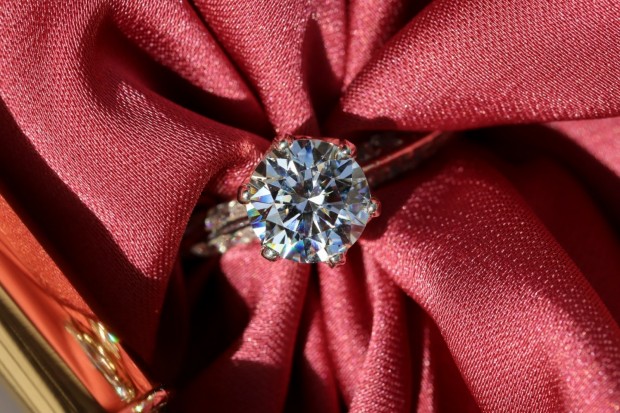The 4 Cs Demystified: A Guide to Evaluating Natural Diamond Quality
- (Photo : Sabrianna on Unsplash)
Have you ever looked through the window of a jewellery store and examined their wide range of diamond rings? Apart from shape and setting, they all look pretty much the same, right?
Wrong. If you're thinking of buying a beautiful diamond—whether that's for an engagement or as a special gift—the first thing you need to know is that every diamond is unique. While they might look similar through a glass window, every diamond has its own particular characteristics and qualities way beyond the price tag.
We would urge you, in this case, not to simply buy the most expensive diamond that fits within your budget. Instead, you can learn about what makes diamonds different and make an educated investment that is far wiser and perhaps even more cost-efficient.
The 4 Cs Demystified
What makes diamonds different, then, are the 4 Cs. These are color, cut, clarity, and carat. Developed by the Gemological Institute of America—or GIA—in the 1940s, the 4 Cs have become the golden—or diamond, if you'll excuse the pun—standard for grading and evaluating the quality of diamonds.
For you as a shopper, understanding the 4 Cs and being able to evaluate them gives you an in to the diamond world that you wouldn't have had before, helping you to make a firm decision while also maximising your budget. This is especially important if you're shopping on a platform like Best Brilliance—with so many special natural diamonds rings to choose from, just knowing that little bit extra can be the difference in ensuring the moment is as perfect as you dreamed it would be.
Color
So, let's start with color. Unless you want to get a specifically colored diamond, you'll be looking for a colorless diamond, and according to the GIA, the more colorless it is, the higher in value it becomes. They discern this by matching a diamond to a color scale, which ranges from 'D' to 'Z.'
Any diamond that falls within the grades 'D-F' is considered colorless, while 'G-J' is near colorless, 'K-M' is faint, 'N-R' is very light, and 'S-Z' is just light. Obviously, the most valuable diamonds, in this case, would be colorless, but near-colorless diamonds are still going to look very clear to the naked eye. Anything ranging from 'K' onwards is going to be noticeably colored, but that's not to say they're an eye-sore. When it comes to the color part of the 4 Cs, we're working with fine margins.
Cut
One of the 4 Cs that you've probably investigated without even realising it is the cut. Obviously, when diamonds are retrieved from the earth, they all look irregular and rough. It's only when they're cut and polished that they become the beautiful, sparkling diamonds that we recognise in jewellery stores. The cut, then, is the most noticeable quality.
In the GIA scale, the cut is distinguished as either 'ideal,' 'excellent,' 'very good,' 'fair,' or 'poor.' To be inserted into one of these categories, a gemologist will examine everything from brightness, fire, scintillation, weight, durability, polish, and symmetry. This is all pretty simple. For instance, the more weight a diamond has, the more sparkle, the more scintillation, etcetera, the more valuable it's going to be. The higher you can stick to the grades, the better chance you have of attaining a diamond of high quality.
Clarity
This is the part where you have to get your magnifying glass out. Or, at least, the gemologist does. The clarity of the diamond is another important factor that can greatly impact its price, and it is determined by how many blemishes and inclusions there are in the internal and surface structure. The GIA clarity scale is split into eleven categories. FL, IF, VVS1, VVS2, VS1, VS2, SI1, SI2, I1, I2, and I3. Together, these stand for: 'flawless,' 'internally flawless,' 'very, very slight inclusions,' 'very slight inclusions,' 'slight inclusions,' and 'inclusions.'
While most of these blemishes and inclusions may be impossible to see with the naked eye, some can be more prevalent and work to overwhelm the diamond and decrease its value. Unless your budget is a seismic one, you shouldn't expect to part with a completely flawless diamond, and in many ways, you don't need to. If a diamond appears flawless—or eye-clean—and you know that your partner won't be inspecting it with a magnifying glass, then it can still be a great option that maximises your budget. Grades as low as VS2 and SI1 can be eye-clean, so try not to discriminate based on their grading and use your judgment.
Carat
The last of the 4 Cs is, of course, carat. This refers to both the weight and the size of the diamond, determined by an electronic micro-balance and an optical scanning device to attain a precise measurement and proportion. One carat is generally the most popular for an engagement ring, but diamonds in the 2 and 3 ranges have become more popular in recent years. Once again, a common mistake to make is assuming that the more carats a diamond has, the better it will be. But choosing a diamond based on its carat doesn't necessarily mean you'll be left with a good diamond.
For instance, a 0.7-carat round diamond can appear smaller compared with a 0.7-carat pear diamond, and sometimes, a smaller carat can appear larger than a larger carat. This all comes down to the cut and shape, so you should make sure to take everything into account when making your choice. Use your eyes, determine your preferences, and take all of the 4 Cs into account before you make the big decision. Good luck!














